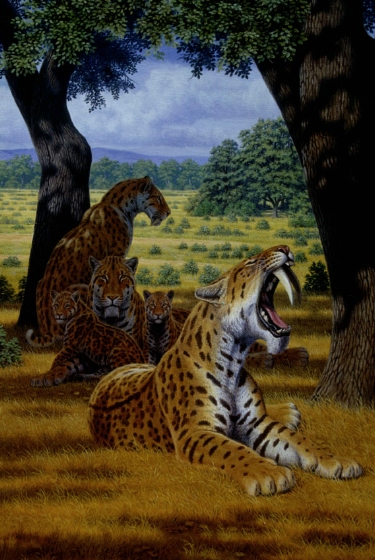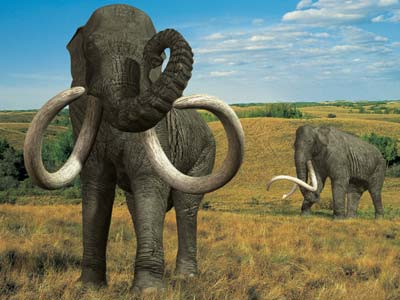![]()
La Cultura de los Indios Clovis, Extinción de la Megafauna y los Paisajes de Suelos
Durante el final de la última glaciación cuaternaria se produjeron varias pulsaciones climáticas enormemente bruscas frió-calor-frío-calor, hasta entrar en el Holoceno, en donde rápidamente surgió la agricultura (Neolítico). Hablamos de las pulsaciónes del Dryas antiguo y reciente. Como veréis pinchando en este último enlace, existen teorías para todos los gustos a la hora de explicar la razón de cambios climáticos tan abruptos. ¡Y como no!, ya que los mamut norteamericanos desaparecieron durante ese evento (junto con otros grandes mamíferos como los camélidos), los climatófilos actuales vuelven la vista a las grandes emisiones de metano que debían petar tales enormes bestias al recorrer las ¿praderas? Cuando desaparecieron el gas de marras pudo descender sus concentraciones en la atmósfera, dando lugar al Dryas reciente. Ya que por allí, ya pululaba la cultura de los indios Clovis, cazadores de estos gigantes lanudos, mutatis mutandis, ahora ciertos “expertos claman, que esta cultura indígena fue la inductora de la gran primera crisis climática causada por la humanidad. Así, como casi siempre, se barre para la casa del Tío Sam. “La Gran Crisis de la Flatulenta” (hoy padecemos la fraudulenta). ¿Quién ha dicho que el hedor es malo? ¿Quién defiende ahora la bondad de los Clovis, por cuya causa se extinguió la megafauna, el clima se congeló, etc. ?

Tigres con diente de sable en las grandes llanuras americanas. Fuente: Anthropology.net
La investigadora Felisa, como veréis en la noticia que hoy reproducimos de Terradaily, avala la argumentación expresada en el párrafo anterior. Empero en los otros enlaces ya expuestos, se defienden causas alternativas tan razonables como la de la mega-inundación que interrumpió la corriente termohalina, de la que ya hablamos en un post precedente. Y por no dejar de disparatar que no quede: ¿Si nos alimentáramos de grandes herbívoros hasta casi exterminarlos durante las fases cálidas y nos tornamos vegetarianos durante las frías, dejando aquellos a sus “flatulentos aires”, podríamos regular el clima. Supongo que Felisa estaría de acuerdo. Dejando a la tía Felisa tranquila, veamos algunos puntos clave de esta controversia.
(i). Se especula mucho sobre si el hombre o el clima fueron causantes de las grandes crisis cuaternarias. Sin embargo, las interacciones clima-hombre, como se comenta en este caso, no den ser soslayables, sino todo lo contrario.
(ii) Las extinciones de los grandes mamíferos, así como de los vertebrados gigantes que les reemplazaban a aquellos en sistemas los insulares, son diacrónicas y generalmente asociadas a la presencia de seres humanos.
(iii) Las megainundaciones causadas por la ruptura de presas de hielo durante la última desglaciación tampoco parecen haber sido sincrónicas, ya que los datos de los cambios climáticos de que disponemos “actualmente” atestiguan que no se produjeron exactamente al mismo tiempo en todo el planeta.

Mamuts en Arizona. Fuente: The Archeology or Arizona according to T-rat.com
(iv) No se puede especular sobre la implacable agresividad de los clovis obsesivamente antiflatulentos, por cuanto las estepas euroasiáticas atesoraban mucha mayor extensión, mientras sus moradores también se alimentaban de Mamuts y otras especies de una megafauna también extinta. ¿Se comunicaban los humanos de entonces móvil, o les bastaba el “tan-tan”?: ¡carguémonos a estos hediondos bichos que apestan!. ¡Ok recibido, camarada Manutchof!.
(v) Resulta comprensible, que ciertos debates duren algún tiempo, a falta de pruebas, pero cansa hasta la desesperación que cada año, los “climatófilos” y los “humanodepredators” se aticen al menor indicio adicional que aparezca. Pero con las predicciones de los modelos de simulación numérica (según las diferentes asunciones utilizadas en cada uno) tal modo de proceder deviene en exponencialmente infraccionario (¿o infraccionario?). Eso sí, sus papers cuelan en las revistas de mayor impacto. ¿Se trata de ciencia buena?
(vi) Otra gran fuente de metano resultan ser los suelos de permafrost y turberas, cuando se deshielan. Empero como los zoólogos no parecen leer de vegetación, ni los botánicos de suelos (….).
(vii) Lo que si parece estar bastante claro, con las evidencias actuales, es que una gran megafauna se extinguió asincrónicamente desde la última glaciación. Si “asumimos” (pero hay que demostrarlo) que los grandes rebaños metanogénicos requieren amplios espacios abiertos, lo que queda en entredicho es asumir la presencia de bosques en muchas regiones del planeta, cuando posiblemente debieran atesorar estructuras sabanoides. Y tal cambio en la estructura de la vegetación si acarrearía modificaciones en el clima, pero también que tanto los suelos como su ecología. Estos difieren ostensiblemente bajo bosques y coberturas herbáceas. Resulta que, sobre este tema, parece investigarse menos. Sin embargo, también existen retroalimentaciones significativas suelo-clima. Así que……… ¿A si que qué, que de qué?. En una o dos semanas, en Nature o Science, volverán a las andadas ¿que fué antes, el huevo o la gallina? “once again”. ¿Ciencia de vanguardia?. No, simplemente ciencia especulativa alimentada mediáticamente. Y la pregunta del millón: ¿Poque actualmente tan solo atesoramos sabanas en África?
Y el octavo día Dios trajo al mundo los grandes herbívoros, con su hediondo metano y (…) el clima se calentó, comenzando a oler todo mal, muy mal. El hombre no supo entender que el divino creador nos regaló estos enormes bichos para que él, gestionándooslos, pudiera cambiar el clima a su antojo. Y seguimos sin percatarnos ¿?.
Lamentablemente continuará………….
Juan José Ibáñez
Earth Blows Hot And Cold
Terradaily: by Alison Hawkes for Hot Zone blog: Moffett Field CA (SPX) Jun 16, 2010
Around 12,000 years ago, the Earth spun into The Big Freeze, a (geologically) brief cold snap known as the Younger Dryas event. Glaciers returned to parts of the Northern Hemisphere and humans who were around then probably shivered quite a bit.
The Clovis people in North American, the first paleo-Indian inhabitants that made distinctive bone and ivory tools, took a population nosedive. What caused The Big Freeze?
The prevailing theory is a shutdown of the ocean conveyor belt caused by a rapid influx of fresh water from the melting of an immense glacial lake – Lake Agassiz – the used to cover much of Canada. Comets are also speculated culprits. But a New Mexico team of researchers is looking into an unusual contributing factor – a steep decline in large animal flatulence.
It’s no secret that humans probably caused the extinction of megafauna species in the New World, which used to be richer than modern day Africa. Within a thousand years of human arrival, species like mammoth, camelids (the ancestors of camels) and giant ground sloths were destined as museum pieces.
In a paper published in Nature Geoscience this month, Methane Emissions from Extinct Megafauna, Felisa Smith of the biology department at the University of New Mexico and colleagues, attribute a steep drop in atmosphere methane levels to the disappearance of these behemoths.
If domestic livestock contributes about 20 percent of global methane emissions today, then mammoths and the like must have had powerful bowels. Since Pleistocene methane levels were considerably lower than today, these megaherbivores might have had a larger influence on global methane levels.
The researchers went about estimating how much gas an 8-ton herbivore would emit. They examined 114 herbivores that went extinct at the end of the Pleistocene epoch, adjusting for body size and other traits to compute overall methane production from these beasts.
Their calculation suggested that the Pleistocene extinction dropped methane levels by about 9.6 teragrams (or megatons), making the mass extinction responsible for somewhere between a 12.5 to 100 percent of overall methane decline. That’s a big range, but the researchers go on to point out a unique attribute of global methane decline at that time. It happened quite quickly, two to four times faster than any other time interval, «which suggests that novel mechanisms may be responsible.»
Novel, indeed. The overall drop in methane, a potent greenhouse gas, during that epoch equated to temperatures 16 to 22 degrees Fahrenheit cooler. The researchers write: The attribution and magnitude of the Younger Dryas temperature shift, however, remain unclear. Nevertheless, our calculations suggest that decreased methane emissions caused by the extinction of the New World megafauna could have played a role in the Younger Dryas cooling event. They go on to say that the megafauna extinction may have been «the earliest catastrophic event attributed to human activities.» It may even be the first time humans altered the climate.
Massive wildfires that cause untold destruction of life and habitat are becoming a feature of modern climate change. A mere 1.8 degree jump in temperature is predicted to equal a 40 percent increase in lightening, the main ignition source of natural fires. We already get some 8 million strikes a day under modern atmospheric conditions. It’s becoming sizzling hot here on Earth.
New research into the past is backing up modern day observations. In a paper published in May in Nature Geoscience, researchers at University College Dublin and colleagues tracked down climate and fire conditions from 200 million years ago during a major environmental transition period in Earth’s history – the Triassic-Jurassic boundary. During this period, massive volcanism broke apart the super-continent of Pangaea and spiked CO2 levels from 600 to more than 2,100 parts per million by volume. For comparison, Earth’s current CO2 concentration is about 391 ppmv, an all time high for recent history. The resulting mass extinction gave way to our most imaginative period in paleo-history – the age of large dinosaurs. Common, too, emerged the conifers – woody plants with thin needles and seed-bearing cones.
What the researchers found was that as CO2 spiked, so did the number of fires. They looked at about 15,500 fossil charcoal particles from this time period in East Greenland and discovered a five-fold increase in charcoal abundance during peak CO2 levels. The vegetation also appeared to be changing. As temperatures rose, broad-leafed plants died off and were replaced by narrow-leafed varieties. These narrow-leafers were able to withstand higher temperatures, but were also more prone to burn because they contained less moisture. Just think of the last campfire you built – what do you throw in to really get it going? Pine needles.
The researchers suspect a positive feedback loop emerged. As more lightening struck, the ignition rates and spread of wildfires increased due to the burn-prone vegetation, which then released more carbon back into the atmosphere and exacerbated the conditions even more.
What this says about modern day climate change is informative. All that fiery turmoil during the Triassic-Jurassic boundary happened with a temperature change of about 7 degrees Fahrenheit

[…] los pobres y flatulentos Mamuts. También explicamos y criticamos tal propuesta en nuestro post “La Cultura de los Indios Clovis, Extinción de la Megafauna y los Paisajes de Suelos”. Sin embargo, por nuestra estulticia y el imperio del poder económico, perdimos la batalla del […]